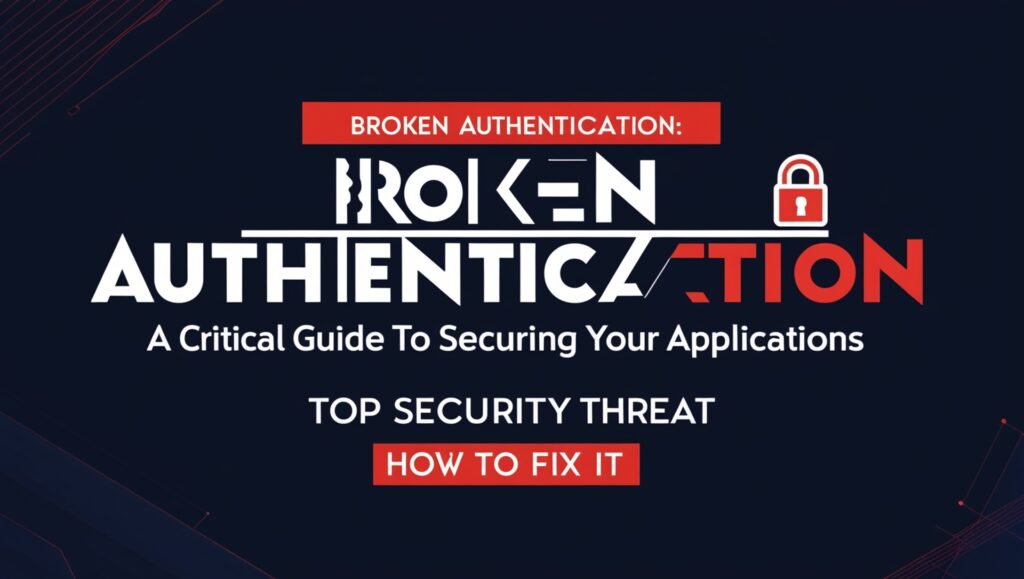1. What is Broken Authentication?
Broken Authentication is a critical security vulnerability that occurs when an application’s authentication mechanisms are improperly implemented, allowing attackers to bypass security protocols and gain unauthorized access to sensitive systems. This issue is part of the OWASP Top 10 Vulnerabilities and poses significant risks to organizations, such as data breaches, account takeovers, and identity theft.

2. How Does Broken Authentication Work?
Broken Authentication works by exploiting weak or flawed authentication processes in applications. Attackers target vulnerabilities like insufficient password policies, insecure session management, or the absence of multi-factor authentication. For example, an attacker may use credential stuffing, where they utilize previously stolen login credentials to access user accounts across different platforms.
3. Common Causes of Broken Authentication
Broken Authentication often arises due to several common issues, including:
- Weak password policies allowing users to set predictable passwords.
- Lack of account lockout mechanisms after multiple failed login attempts.
- Improper session management, such as session IDs not being invalidated after logout.
- Reuse of old or stolen credentials in systems without multi-factor authentication.
- Absence of HTTPS, exposing login credentials to eavesdroppers.
4. Real-World Examples of Broken Authentication Attacks
Real-world cases highlight the dangers of Broken Authentication. Some notable examples include:
- Uber (2016): Attackers exploited poor session management to take over driver and user accounts, exposing sensitive information.
- GitHub (2018): Hackers used credential stuffing attacks to compromise user accounts by leveraging reused passwords from data breaches.
- Facebook (2019): A flaw in access tokens allowed unauthorized access to user accounts, affecting over 50 million users.
5. Impact of Broken Authentication on Security
The impact of Broken Authentication can be catastrophic for both users and organizations:
- Data Breaches: Sensitive user data like passwords, emails, and payment information may be exposed.
- Account Takeovers: Attackers can gain full control over user accounts, potentially performing fraudulent activities.
- Financial Losses: Organizations may face lawsuits, fines, and reputational damage.
- Regulatory Non-Compliance: Failing to secure authentication mechanisms can lead to penalties under regulations like GDPR.
6. Common Vulnerabilities Leading to Broken Authentication
Broken Authentication often stems from the following vulnerabilities:
- Weak Passwords: Users choosing simple or reused passwords.
- No Multi-Factor Authentication (MFA): Lack of additional security layers makes accounts easier to compromise.
- Session Fixation Attacks: Attackers steal valid session tokens to impersonate users.
- Brute Force Attacks: Exploiting systems with no rate limiting to guess passwords.
- Unencrypted Login Pages: Exposing credentials to interception during transmission.
7. How to Identify Broken Authentication in Applications
Identifying Broken Authentication involves thorough testing and analysis:
- Check Login Mechanisms: Ensure proper password policies, CAPTCHA, and account lockouts are implemented.
- Analyze Session Management: Verify that session tokens are unique, securely stored, and invalidated after logout.
- Monitor Logs: Track suspicious login attempts or failed authentication attempts.
- Penetration Testing: Use ethical hacking techniques to simulate attacks and uncover vulnerabilities.
8. Testing for Broken Authentication: Tools and Techniques
Testing for Broken Authentication can be conducted using various tools and methods, such as:
- Burp Suite: To test for insecure session handling and weak authentication mechanisms.
- OWASP ZAP: To identify vulnerabilities in login forms and session management.
- Hydra: A tool to perform brute force attacks and check for weak passwords.
- Manual Testing: Simulating real-world attacks, such as session fixation or credential stuffing.
9. Preventing Broken Authentication: Best Practices
To prevent Broken Authentication, organizations must implement these best practices:
- Enforce Strong Password Policies: Require complex passwords and prohibit reused credentials.
- Enable Multi-Factor Authentication (MFA): Add an extra layer of security.
- Implement Rate Limiting: Prevent brute force attacks by limiting login attempts.
- Secure Session Management: Use unique, encrypted session tokens that expire after inactivity.
- Adopt HTTPS: Encrypt all traffic between users and the application.
10. OWASP and Broken Authentication: Guidelines and Examples
The OWASP Top 10 emphasizes Broken Authentication as one of the most dangerous vulnerabilities. OWASP recommends:
- Using secure frameworks with built-in authentication features.
- Regularly updating and patching software to fix known vulnerabilities.
- Employing automated tools like OWASP ZAP to detect and remediate authentication flaws.
For example, OWASP illustrates how session hijacking and credential stuffing attacks occur due to improper implementation of authentication systems.
11. Role of Developers in Mitigating Broken Authentication
Developers play a crucial role in minimizing Broken Authentication risks by:
- Writing secure code and following secure development practices.
- Validating user inputs to avoid exploitation of login forms.
- Integrating libraries and frameworks that support secure authentication.
- Conducting regular code reviews and security testing.
- Educating themselves on the latest authentication vulnerabilities and trends.
12. Future Trends in Authentication Security
As technology evolves, the future of authentication focuses on advanced and secure methods:
- Biometric Authentication: Using fingerprints, facial recognition, and voice for secure logins.
- Passwordless Authentication: Transitioning to token-based or device-based authentication to eliminate password vulnerabilities.
- Zero-Trust Security Models: Continuously verifying user identities at every stage.
- AI-Driven Security: Employing machine learning to detect and prevent authentication-related threats.
13. Conclusion
Broken Authentication remains a significant security threat, but understanding its causes, impacts, and prevention strategies can help mitigate risks. By implementing strong password policies, using multi-factor authentication, and following OWASP guidelines, organizations can reduce vulnerabilities and protect their systems from potential attacks. Developers must stay updated with evolving trends to ensure secure authentication mechanisms in their applications.
Check More Blog:- https://thetechcrime.com/how-to-use-john-the-ripper/
Check My YouTube Chenal:-https://www.youtube.com/@Thetechhacker231/videos

Leave a Reply